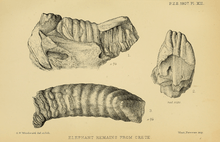Mammuthus creticus
Mammuthus creticus, or the Cretan dwarf mammoth, is an extinct species of dwarf mammoth. With a shoulder height of about 1 m and a weight of about 310 kg,[1] it was the smallest mammoth that ever existed.[2]
| Mammuthus creticus Temporal range: Late Pleistocene | |
|---|---|
 | |
| Skeleton in the Netherlands | |
| Scientific classification | |
| Kingdom: | Animalia |
| Phylum: | Chordata |
| Class: | Mammalia |
| Order: | Proboscidea |
| Family: | Elephantidae |
| Genus: | †Mammuthus |
| Species: | †M. creticus |
| Binomial name | |
| †Mammuthus creticus (Bate, 1907) | |
| Synonyms | |
|
Palaeoloxodon creticus Bate, 1907 | |
After DNA research published in 2006, it was proposed to rename Palaeoloxodon creticus into Mammuthus creticus (Bate, 1907).[3] Others proposed (in 2002)[4] to rename all the described specimens of larger size under the new subspecies name Elephas antiquus creutzburgi (Kuss, 1965). In a study of 2007, it was argued for the groundlessness of the theory by Poulakakis et al. in 2006,[3] showing the weak points of that DNA research.[5] However, morphological data is at least equivocal, and may also support placement in Mammuthus.

Skulls of Cretan mammoths or of other dwarf elephant species on Mediterranean islands have been suggested as the basis for the ancient Greek myth of Cyclopes.[6]
References
- Larramendi, A. (2016). "Shoulder height, body mass and shape of proboscideans" (PDF). Acta Palaeontologica Polonica. 61. doi:10.4202/app.00136.2014.
- Herridge, V. L.; Lister, A. M. (2012). "Extreme insular dwarfism evolved in a mammoth". Proceedings of the Royal Society B: Biological Sciences. 279 (1741): 3193. doi:10.1098/rspb.2012.0671. PMC 3385739. PMID 22572206.
- Poulakakis, N.; Parmakelis, A.; Lymberakis, P.; Mylonas, M.; Zouros, E.; Reese, D. S.; Glaberman, S.; Caccone, A. (2006). "Ancient DNA forces reconsideration of evolutionary history of Mediterranean pygmy elephantids". Biology Letters. 2 (3): 451–454. doi:10.1098/rsbl.2006.0467. PMC 1686204. PMID 17148428.
- Poulakakis, Nikos; Mylonas, Moysis; Lymberakis, Petros; Fassoulas, Charalampos (2002). "Origin and taxonomy of the fossil elephants of the island of Crete (Greece): problems and perspectives". Palaeogeography, Palaeoclimatology, Palaeoecology. Elsevier BV. 186 (1–2): 163–183. doi:10.1016/s0031-0182(02)00451-0. ISSN 0031-0182.CS1 maint: ref=harv (link)
- Orlando, L., Pagés, M., Calvignac, S.; et al. (2007-02-22). "Does the 43bp sequence from an 800000 year old Cretan dwarf elephantid really rewrite the textbook on mammoths?". Biology Letters. 3 (1): 57–59. doi:10.1098/rsbl.2006.0536. PMC 2373798. PMID 17443966.CS1 maint: multiple names: authors list (link)
- This suggestion of Othenio Abel is noted by Adrienne Mayor, The First Fossil Hunters: Paleontology in Greek and Roman Times (Princeton University Press) 2000 ISBN 1400838444.